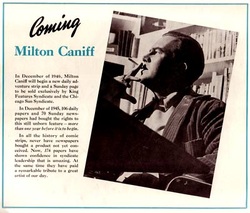
(28 February 1907 - 3 May 1988, USA)
Milton Caniff's first involvement in the comics field dates from 1922, when he began working as an illustrator for some local newspapers. At age 25, Caniff was hired by Associated Press, and brought to New York in 1932. He ghosted on features like 'The Gay Thirties', before taking over the panel cartoon called 'Mister Gilfeather' from Al Capp in September 1932.
Caniff was handed the assignment of a children's adventure strip called 'Dickie Dare'. Influenced by such strips as 'Flash Gordon' and 'Brick Bradford', Caniff took Dickie on the ride of his life.
It was Joseph Patterson at the New York Daily News who noticed the 'Dickie Dare' strip and quickly hired Caniff for a new adventure strip called 'Terry and the Pirates'. The strip made its debut in October, 1934. In the beginning, the comic was fairly rough, until Noel Sickels, who was hired to produce the strip 'Scorchy Smith', helped Caniff iron out the wrinkles.
Their collaboration - and Caniff's later solo flight - produced some of the most memorable strips in the history of the medium. They also did advertising work together, such as the 'Mr. Coffee Nerves' character, using the penname Paul Arthur.
During World War II, Caniff produced, besides 'Terry', the comic strip 'Male Call' for the G.I. Newspapers only. It featured Miss Lace, a sprightly pal to every homesick soldier and sailor away from the U.S. 'Male Call' was Caniff's donation to the war effort; he took no money for it. He retired the strip in 1946.
In early 1947, Caniff, aching for more control of his comic creations, jumped to the Chicago Sun - Times and created 'Steve Canyon', a strip about an air-transport pilot seeking adventure.
Although 'Steve Canyon' was an immediate success, the strip never matched 'Terry' at its best. 'Steve Canyon' ran for 41 years and died with the artist in 1988. The final strip, on June 4th, was a two-panel tribute, signed by 78 cartoonists.
Gaining the highest regard of his peers, Caniff earned the very first Cartoonist of the Year trophy awarded by the National Cartoonists Society in 1946, and eventually received the Reuben award for his work in 1971.
The impact Milton Caniff had on comics cannot be overestimated; he was the first cartoonist who brought realism, suspense and sensuality into comics and he inspired many artists with his beautiful drawings, earning him his nickname, "the Rembrandt of the comic strip."
(wikipedia.org)
 RSS Feed
RSS Feed


